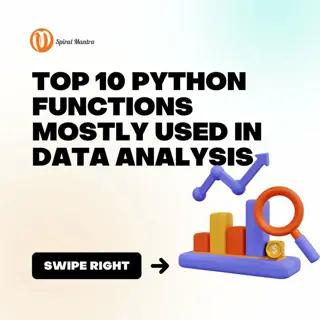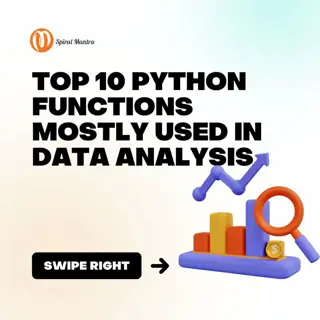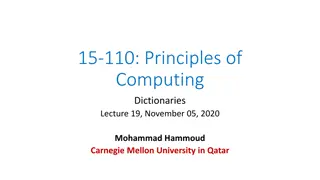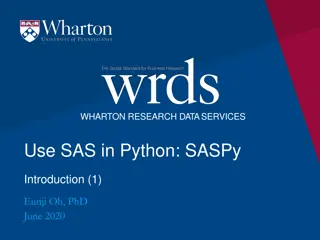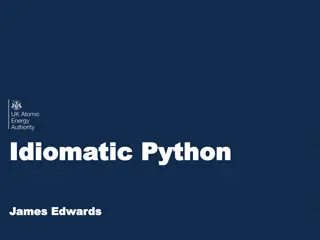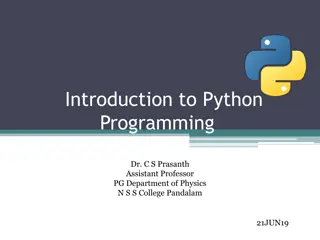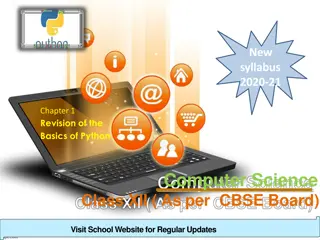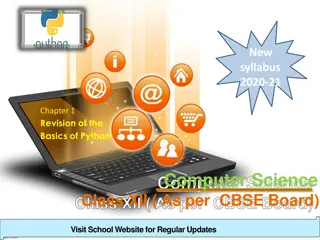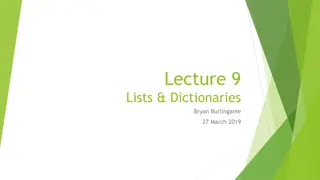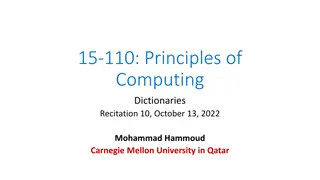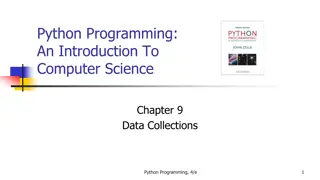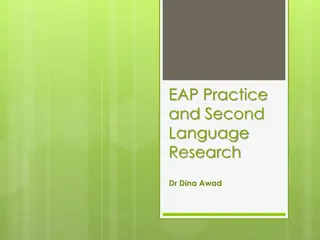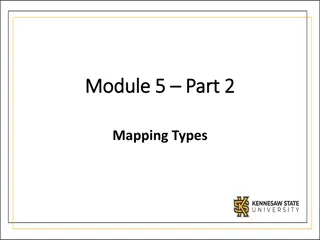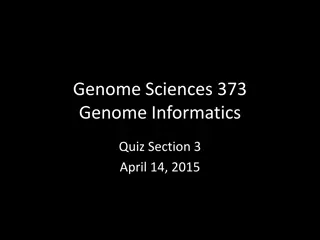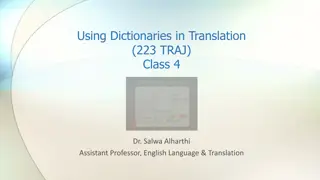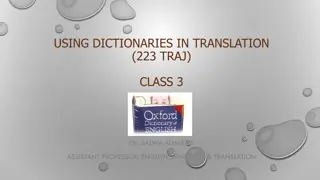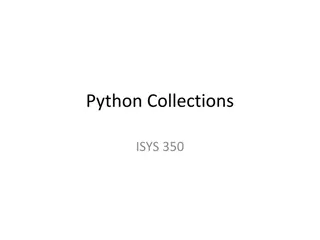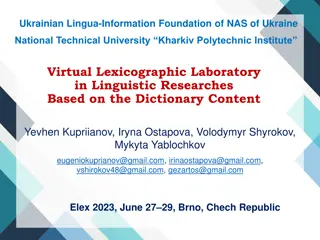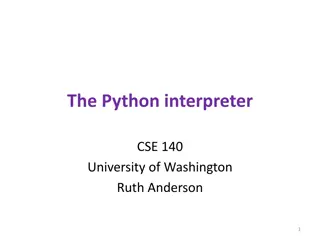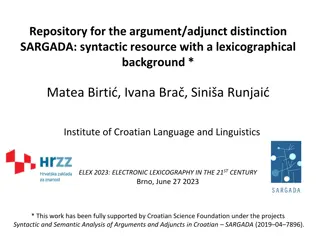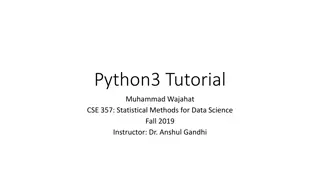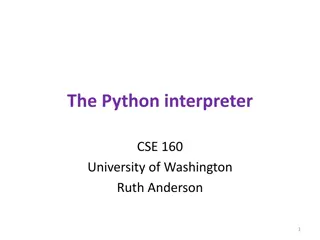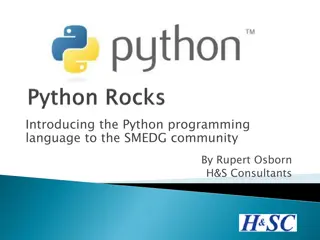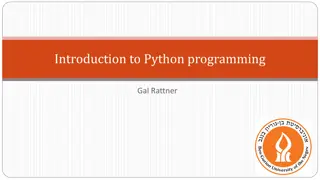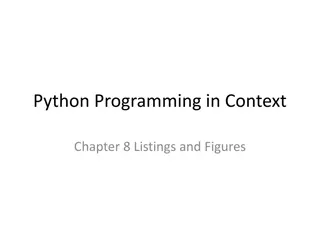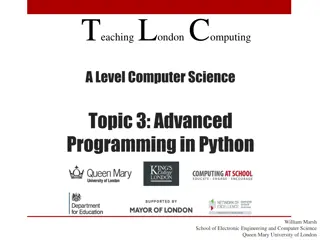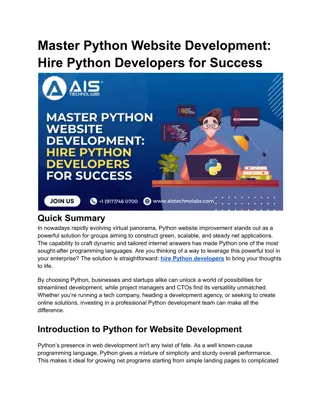Environments,Tuples,& Dictionaries
Explore the concepts of environments, tuples, and dictionaries in Python through visual diagrams and explanations. Learn about how Python interprets programs, assignments, functions, and function calls within different frames and environments. Discover the rules for name lookup in user-defined funct
3 views • 27 slides
Top 10 Python Functions
\nEmbark on a journey through Python's programming landscape with our curated selection of the \"Top 10 Python Functions.\" Dive into the versatility of these functions, from slicing and dicing strings to gracefully traversing complex data structures. Master Python's toolkit and revolutionize your c
5 views • 7 slides
Top 10 Python Functions
\nEmbark on a journey through Python's programming landscape with our curated selection of the \"Top 10 Python Functions.\" Dive into the versatility of these functions, from slicing and dicing strings to gracefully traversing complex data structures. Master Python's toolkit and revolutionize your c
2 views • 7 slides
Dictionaries in Python
Dictionaries in Python allow storing elements with keys of various hashable types and values of any data type. Keys must be unique, but values can be duplicated. Dictionaries cannot be concatenated but can be nested. When passed to a function, dictionaries exhibit pass-by-reference behavior due to t
3 views • 14 slides
Introduction to SASPy: Using SAS in Python
Learn about SASPy, a Python API to the SAS system that allows for seamless interaction between SAS and Python environments. Explore how to start a SAS session, exchange data between SAS datasets and Pandas data frames, and utilize various useful methods. Discover the benefits of incorporating SASPy
1 views • 11 slides
Python for Delphi Developers Webinar Overview
This webinar provides insights into the growing popularity of Python for Delphi developers. It showcases the potential synergies between Python and Delphi, highlighting the advantages and opportunities for developers in integrating these two languages. The session covers accessing Python libraries f
2 views • 23 slides
Mastering Idiomatic Python Programming Techniques
Idioms in Python, whether in natural language or programming, are expressions that simplify tasks and enhance code readability and maintainability. Using idioms in coding can also facilitate peer review. While not mandatory, learning idioms through practice, reading good source code, and self-review
2 views • 40 slides
Introduction to Python Programming at N.S.S. College: A Brief Overview
Python is a high-level programming language known for being open-source and community-driven. Developed by Guido van Rossum in the late 1980s, Python has evolved over the years to become a versatile language with a rich history. This overview touches upon Python's key features, timeline/history, and
1 views • 42 slides
Overview of Python Programming for Class XII Computer Science
This chapter provides a comprehensive revision of the basics of Python programming for Computer Science students in Class XII as per the CBSE Board syllabus. It covers the introduction, features, shortcomings, and practical aspects of working in Python, including interactive mode and script mode. Th
2 views • 61 slides
Basics of Python for Class XII Computer Science - CBSE Board
Comprehensive overview of Python programming language covering its introduction, features, shortcomings, and how to work in Python interactive and script mode. The content also emphasizes the importance of Python in software development, web development, system scripting, and mathematics alongside p
1 views • 61 slides
Object-Oriented Programming (OOP) in Python
Python is a versatile programming language that supports various programming approaches. Object-Oriented Programming (OOP) is a popular method in Python where objects are created to solve programming problems. OOP in Python focuses on creating reusable code, following the principle of DRY (Don't Rep
2 views • 35 slides
Introduction to Lists and Dictionaries in Python
This lecture discusses Lists and Dictionaries in Python programming. It covers the differences between these two data structures, their usage, variable storage, and handling larger data sets. The session introduces Lists as containers for related data pieces and explains how to create, access, and m
3 views • 36 slides
Dictionaries in Python
Dictionaries in Python allow you to store elements with keys of any type and values of any type. They can contain any and different types of elements, have unique keys but can have duplicate values, cannot be concatenated or repeated, can be nested, and are mutable like lists. Dictionaries can be it
0 views • 13 slides
Comparative Analysis of Student Struggle in Python vs. C++ for Small Coding Exercises
An analysis conducted by Nabeel Alzahrani, Frank Vahid, Alex Edgcomb, Kevin Nguyen, and Roman Lysecky compared student struggles in Python and C++ for small coding exercises in introductory programming courses. The study explored the ease of learning Python compared to C++ and the demand for Python
2 views • 17 slides
Introduction to Python for Java Professionals
Explore the transition from Java to Python with key differences, advantages of Python, suitable environments for coding, and a comparison of basic program structures between the two languages. Discover why Python is preferred for machine learning projects and where to write and run Python code onlin
3 views • 15 slides
Introduction to Data Collections in Python Programming
In this introduction to computer science chapter, you will explore the use of lists, tuples, and dictionaries in Python to represent and manipulate collections of data. Learn about the functions and methods available for working with Python lists and understand how to group related values using tupl
1 views • 58 slides
Insights into Second Language Learning Research
This presentation delves into various aspects of second language learning research, including the use of dictionaries, part-of-speech explanation, grammatical rules, and bilingual dictionary use. Studies show mixed results on the effectiveness of meta-analysis in form-focused instruction and the imp
0 views • 26 slides
Python Dictionaries: Key-Value Mapping
Python dictionaries are key-value mappings where elements are stored as key-value pairs instead of being indexed by numbers like in sequences. Dictionaries allow unique keys and provide efficient ways to create, access, and update key-value pairs in Python programming. Learn how to utilize dictionar
2 views • 10 slides
Genome Sciences 373: Informatics Quiz, Python Dictionaries, and Conditional Statements Overview
Today's session covers topics such as Python dictionaries with in-class examples, iterating through dictionary entries, counting repeating characters in a string, and understanding if/elif/else statements. The session also includes a discussion on combining tests in Python and comparisons operators.
0 views • 41 slides
Introduction to Python: Explore Python Labs
In this Python Lab series, delve into the fundamentals of Python programming. Discover the origins of Python, its unique features, and how to create and run Python scripts. Engage in hands-on assignments to enhance your Python skills, including experimenting with print statements, loops, and more.
0 views • 5 slides
Python Iterators and Generators
Explore the concept of iterators and iterable objects in Python. Learn how to use iterators to access elements one by one in an iterable object. Discover the sequential access provided by iterators and how to create iterators for various iterable objects like lists, tuples, dictionaries, strings, an
0 views • 38 slides
Role of Dictionaries in Translation
Dictionaries play a crucial role in translation by helping users find information about linguistic signs, word division, spelling, and word formation. The lemma serves as a representative of a lexical item in a dictionary, aiding users in locating specific entries. Word division information can assi
1 views • 12 slides
Specialized Dictionaries in Translation: Types and Functions
This informative content delves into the typology of specialized dictionaries, focusing on syntagmatic specialized dictionaries like construction, collocation, and idiom dictionaries. It explains how construction dictionaries specify possible complements for lemmas, while collocation dictionaries hi
0 views • 14 slides
Python Collections: Lists, Tuples, and Dictionaries
Data structures in Python such as lists, tuples, and dictionaries play a crucial role in storing and organizing data. Lists allow storing a collection of diverse data items, tuples provide immutability, and dictionaries facilitate key-value pair storage. Learn how to declare, initialize, access, and
0 views • 42 slides
Computer Lexicography: Bridging Linguistics and Technology in Digital Dictionaries.
Computer lexicography explores the intersection of linguistics and technology to develop effective systems for creating and utilizing lexical resources in digital environments. The shift from traditional paper dictionaries to digital formats like the Spanish Language Dictionary (DLE 23) signifies a
0 views • 26 slides
The Python Interpreter and Running Python Programs
The Python interpreter in CSE 140 at the University of Washington, explained in detail with images. Learn how to run Python using the interpreter, launch it through IDLE, and understand the differences between running Python code in the interpreter and as a program.
2 views • 7 slides
Valency Lexicography and E-Glava: Bridging Syntax and Lexicography
Creating monolingual or multilingual dictionaries, especially valency lexicons, requires a deep understanding of grammatical phenomena across languages. Valency dictionaries provide not only lexical information but also syntactic structures of verbs and the semantic roles of their arguments. E-Glava
0 views • 27 slides
Python Functions for Numerical Computing and Scientific Applications
Functions in Python allow for effective code organization and reusability. This lesson covers defining functions with default values, handling multiple arguments, and advanced argument passing techniques. Examples include doubling a number, calculating sum and difference, and processing lists and di
0 views • 21 slides
Python3 Tutorial for Statistical Methods in Data Science
This tutorial covers the installation of Python on Windows, basic concepts like Hello World, data structures such as variables, strings, lists, dictionaries, and sets, along with useful built-in functions and control flow statements like loops and conditionals. It provides a comprehensive overview f
0 views • 14 slides
Introduction to Python Programming in Context
This content introduces Python programming in context, focusing on Chapter 1. It covers real-world examples of computer science, problem-solving strategies, Python's numeric data types, simple programs, loops, functions, and turtle graphics. With images illustrating concepts like problem-solving alg
0 views • 33 slides
Installing Python 3 for Windows and MacOS
Helpful guide on installing Python 3.6.2 for Windows and MacOS systems. Learn how to determine if you have a 32-bit or 64-bit Windows version, choose the right Python installer for your system, download and install Python, and additional notes for Linux, Android, and iOS users. Keep existing Python
0 views • 10 slides
Introduction to Python and its Applications
Python is a powerful, high-level programming language developed in the late 1980s by Guido van Rossum. Known for its readability and concise syntax, Python offers a range of features such as easy interpretation, object-oriented programming, and a large library. This introduction covers Python's hist
1 views • 69 slides
Comprehensive Overview of IEEE Python Seminar by Tim York at SIUE ECE Department
Explore the detailed insights shared by Tim York during the IEEE Python Seminar held at SIUE ECE Department on Dec 7, 2016. He covered topics such as ways to get Python on different operating systems, basics of Python, numeric analysis, string parsing, Python on SBCs, reasons to choose Python, getti
0 views • 29 slides
Python Interpreter and Running Python Programs
The content explains the concept of the Python interpreter, its role in evaluating expressions, running Python programs, launching the interpreter in Canopy, and the differences between running code in the interpreter vs. running a Python file as a program. It covers the basics of interacting with t
2 views • 7 slides
Introducing Python Programming Language to SMEDG Community
Python, a general-purpose, high-level, object-oriented programming language, is free, open-source, and easy to use. It was started in 1989 by Guido van Rossum and named after Monty Python's Flying Circus. With various releases and a thriving ecosystem of libraries, Python is fast to write, easy to r
0 views • 29 slides
A Comprehensive Overview of Python Programming
Python is a dynamic programming language that has gained immense popularity since its creation in 1991. This article covers topics such as the basics of Python, installation methods including Conda and PyCharm, usage of virtual environments, interpreters, packages like NumPy for mathematics, and syn
0 views • 14 slides
Advanced Examples of Using Dictionaries and Lists in Python Programming
Explore more advanced techniques such as dictionary manipulation, list operations, pattern matching with regular expressions, and using simple programs to solve complex problems in Python programming. Discover methods like cryptanalysis, code breaking, frequency analysis, and rail fence decryption t
0 views • 22 slides
Customizing GPS through Python for Enhanced Integration
In this guide, we explore how to customize GPS using Python for better integration, particularly focusing on the GNATprove tool. By leveraging Python plugins and the Python Console within GPS, users can tailor their GPS experience to meet specific project requirements, enhancing the overall function
0 views • 8 slides
Advanced Python Programming: Arrays, Exceptions, and More
Explore advanced programming topics in Python, including arrays of multiple dimensions, Python built-in types like tuples and dictionaries, and handling exceptions. Dive into representational challenges like those in Minesweeper and Hangman, and discover the significance of arrays in programming. Le
0 views • 31 slides
Master Python Website Development_ Hire Python Developers for Success
Discover Python website development, build web apps, and hire Python developers. Partner with a leading Python development company for scalable solutions.\n\nSource>>\/\/ \/python-web-development\n
0 views • 4 slides

